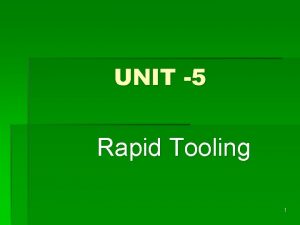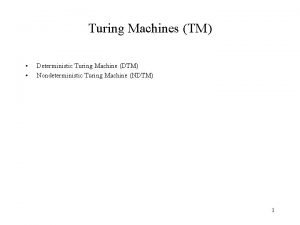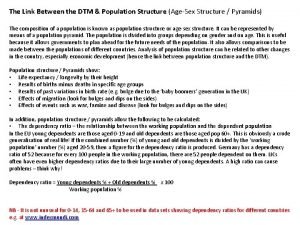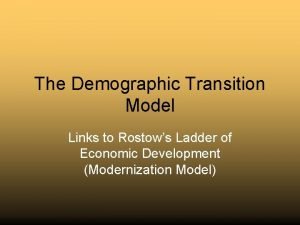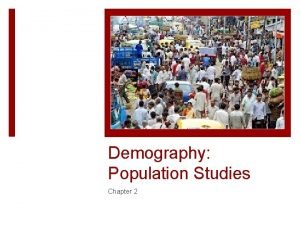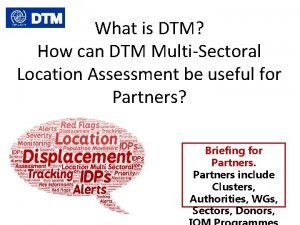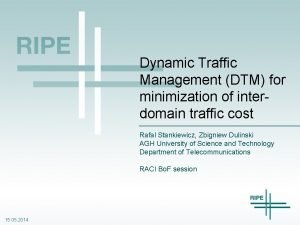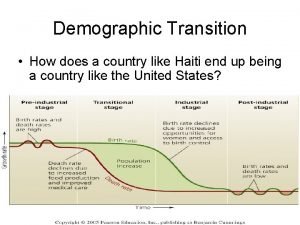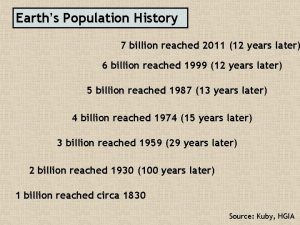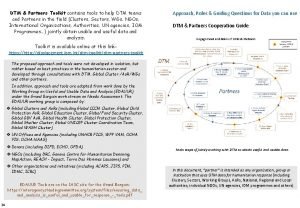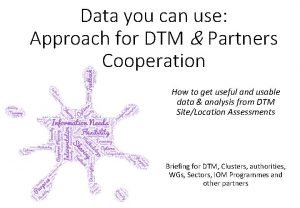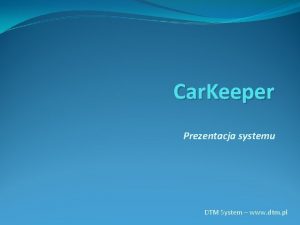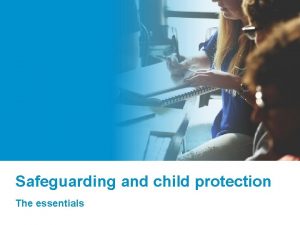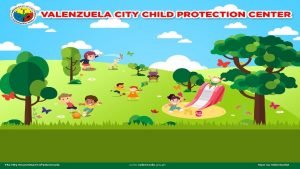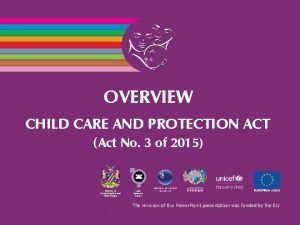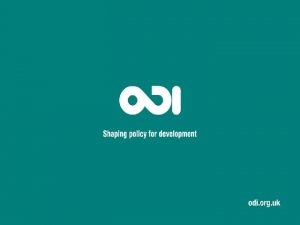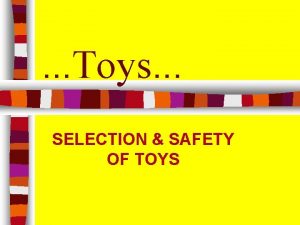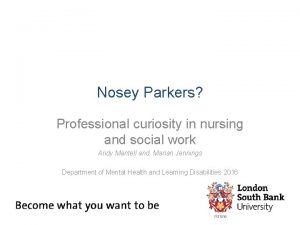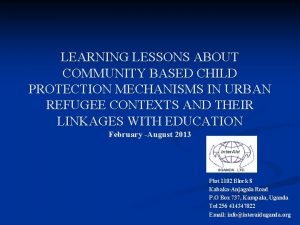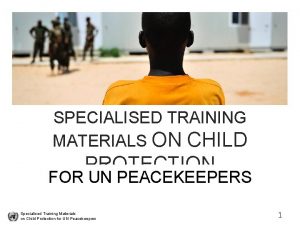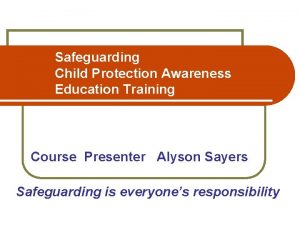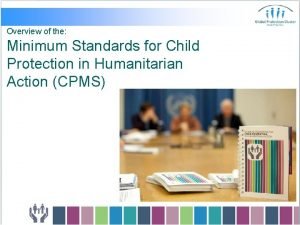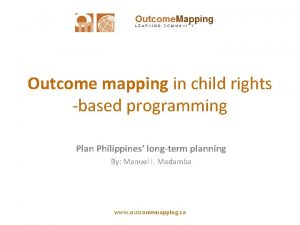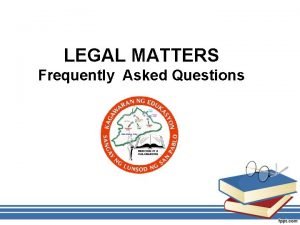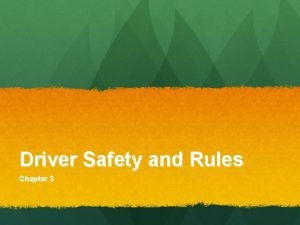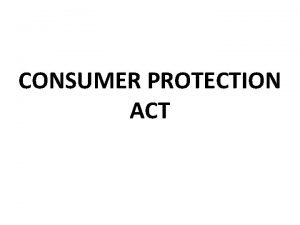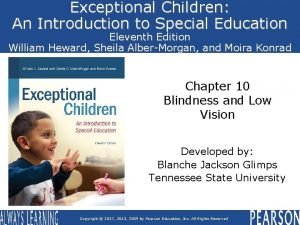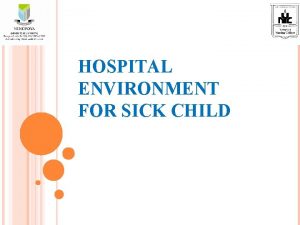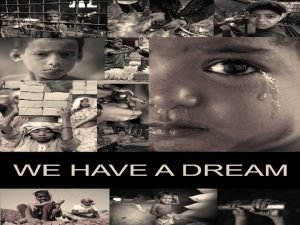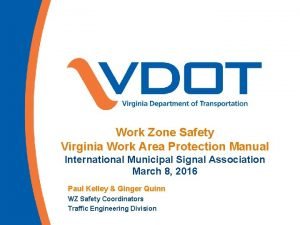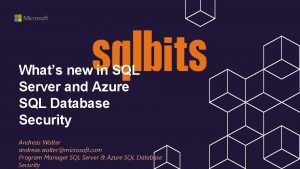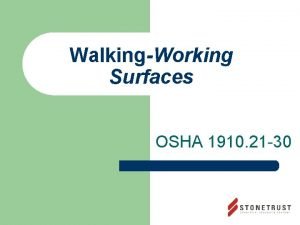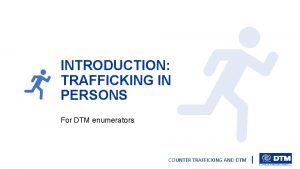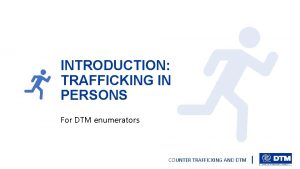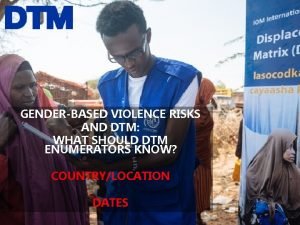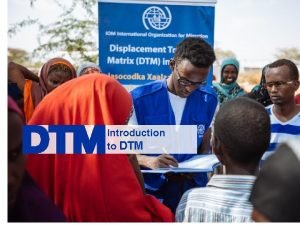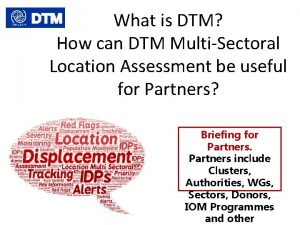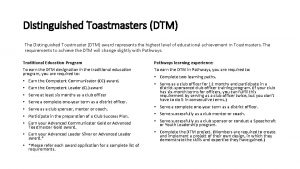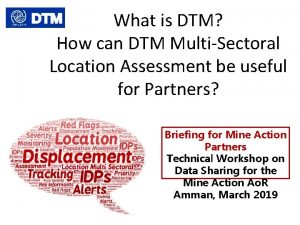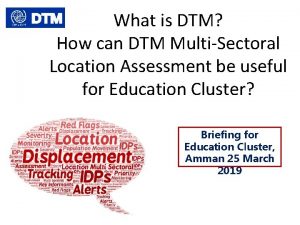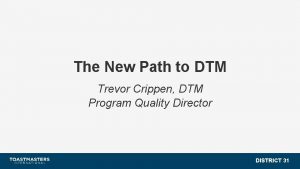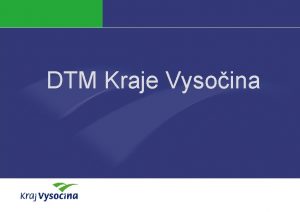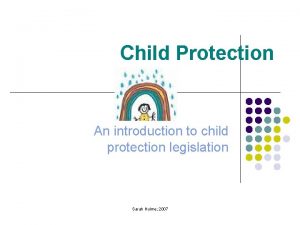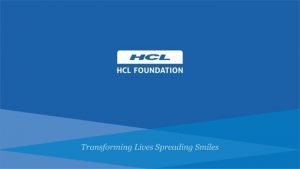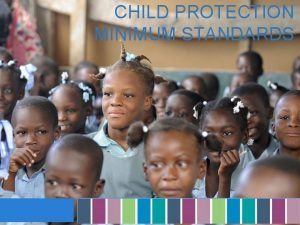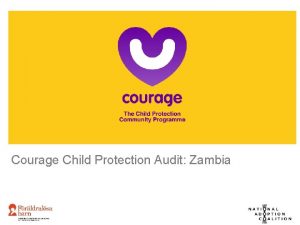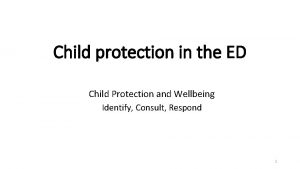INTRODUCTION TO CHILD PROTECTION WHAT DTM ENUMERATORS SHOULD


















































- Slides: 50

INTRODUCTION TO CHILD PROTECTION WHAT DTM ENUMERATORS SHOULD KNOW COUNTRY/LOCATION DATES

Part 1 Introduction to Child Protection CHILD PROTECTION AND DTM

Learning objectives • Work together using a common definition of “child”. • Explain different ways in which emergencies and migration can undermine the protection of children. • Define Child Protection in Emergency (CPi. E). • In your context, articulate the impact of emergencies and/or migration on child protection. CHILD PROTECTION AND DTM

Who is a Child? • Childhood is understood in different ways around the world. For example, some cultures define adulthood not by age, but by the onset of puberty. • How is childhood defined in your culture? Is it only age, or also social roles? • How can this be different in other cultures? • UN Convention on the rights of the child defines a child as: “Every human being below the age of 18 years unless under the law applicable to the child, majority is attained earlier” CHILD PROTECTION AND DTM

Child Rights Right to leisure, play & culture Registration, name, nationality Right to health care Survival & development Freedom of religion Freedom of expression Social security Preservation of identity Parental guidance Right to information Right to live with their parents Freedom of association Right to Education Opinion … CHILD PROTECTION AND DTM

What is Child Protection? • “The prevention and response to abuse, neglect, exploitation and violence against children” – Child Protection Area of Responsibility “ Abuse Deliberate act of ill treatment can harm or cause harm to a child’s safety, well-being, dignity and development All forms of physical, sexual, psychological or emotional ill treatment Exploitation Use of children for someone else’s advantage, gratification or profit resulting in unjust, cruel and harmful treatment Neglect Deliberately (or through carelessness or negligence) failing to provide/secure child’s rights to physical safety and development Violence All forms of physical or mental violence, injury and abuse, neglect or negligent treatment, maltreatment or exploitation, including sexual abuse CHILD PROTECTION AND DTM

Quiz: Which type of child abuse is it? Exploitation Physical Abuse Asking pupils to clean their teachers’ personal living quarters for good grades. Hitting a child that has misbehaved Giving a child alcohol or illegal drugs Forcing a child to beg for money or sell small items (like tissues) to people on the street. Child Marriage Emotional Abuse Repeatedly shaming a child who is not doing well in school Sexual Abuse Forcing a child to watch pornography Threatening to, or touching a child in a sexual manner Keeping a child isolated – away from social interaction Neglect Leaving a small child at home alone all day because his parents are at work. CHILD PROTECTION AND DTM

The Protective Environment How do specialized actors engage? CHILD PROTECTION AND DTM

Risks faced by children in emergency and unsafe-migration contexts Abuse, neglect Child labour Sexual Violence No access to services Child recruitment Family separation No documentation Detention Smuggling, trafficking No Psychosocial wellbeing UXO/ERW… CHILD PROTECTION AND DTM …

Aggravating factors that increase child vulnerability… Teenage pregnancy Disabilities Medical condition Child carer Child Parent Added vulnerabilities CHILD PROTECTION AND DTM UASC

In your context, what are the risks that would be faced by girls and boys… • 0 -5 years • 6 -10 years • 11 -17 years CHILD PROTECTION AND DTM

What is Child Protection in Emergencies? CHILD PROTECTION AND DTM

The Minimum Standards to Address Child Protection Needs CHILD PROTECTION AND DTM

Quiz: Which Standard does each of these risks fall under? CHILD PROTECTION AND DTM

Key messages • Definition of a child: every person below 18 years • The prevention and response to abuse, neglect, exploitation and violence against children. • Children have rights and are entitled to protection and assistance. • Emergencies and unsafe migration may exacerbate child protection risks, present new risks and threats, and undermine existing protection mechanisms. • Emergencies affect people differently depending on their age, sex, wealth, and other factors affecting their vulnerability. CHILD PROTECTION AND DTM

Part 2 DTM and Child Protection CHILD PROTECTION AND DTM

DTM and CP Learning objectives • Become familiar with CP related questions and key definitions • Know the urgent actions you may have to undertake and the referral systems in place • Understand how to avoid doing harm to children CHILD PROTECTION AND DTM

Part 2 DTM and Child Protection Questions CHILD PROTECTION AND DTM

DTM and CP Questions: Definitions Game Terms 1. Child-headed household 2. Unaccompanied child 3. Physical and/or infrastructure risks that can lead to death or injury 4. Risks of VIOLENCE that can lead to death or injury 5. Minor associated with armed groups 6. Psychosocial Support Definitions A. Activities to help individuals and communities to heal the psychological wounds and rebuild social structures after an emergency or a critical event (such as counselling, child friendly spaces, case management). B. Hazards not caused by a person intentionally using force against another person. Examples include: construction issues, exposed wiring, uncovered ditches, vehicle accidents. C. A child that is either an armed fighter, or has a supporting role for an armed group, such as cooking or cleaning. This may or may not be voluntary. D. A household with adults who are unable to be the primary caretakers/livelihoods generators for the household, and in which a child under the age of 18 assumes this responsibility. E. Acts of physical force by a person (or group), intended to hurt, damage, or kill another person (or group) F. A child (under 18 years) who is living with no mother, no father or any other adult relative members

DTM and CP Questions: Do you know the definition? • Child marriage • Child labour • Child Friendly Spaces • Other harmful traditional practices • What is the difference between available humanitarian services and accessible humanitarian services? TIP! When interviewing Key Informants, try not to say “child” when asking questions. Instead say girls/boys/persons under 18 years old. CHILD PROTECTION AND DTM

DTM and CP Questions Separated Children • Separated children are those separated from both parents, or from their previous legal or usual primary caregiver, but not necessarily from other relatives. As a result, this may include children accompanied by other adult family members. Unaccompanied Children • Unaccompanied children (also called unaccompanied minors) are children who have been separated from both parents and other relatives, and who are not being cared for by an adult who, by law or custom, is responsible for doing so. CHILD PROTECTION AND DTM

Is the child… Either with… Not with parents or previous legal or customary caregiver With relatives / extended family or In the care of a government institution (court order) Not with parents or previous legal or customary caregiver or Not with relatives / extended family Un-related adults or With no adult care (could be with related /unrelated children) = Separated child = Unaccompanied Child CHILD PROTECTION AND DTM

DTM and CP Questions: Site Assessment Form With your neighbour: • Go through the site assessment form • Identify all the indicators in the form that could help specialized actors to identify child protection risks • Highlight any words that you don’t understand • Highlight any questions that you think you must not list the potential answers to when asking the key informant • Debriefing will take place in plenary CHILD PROTECTION AND DTM

DTM and CP Questions: Flow Monitoring Survey With your neighbour: • Go through the FMS form • Identify all the indicators in the form that could help specialized actors to identify child protection risks • Highlight any words that you don’t understand • Highlight any questions that you think you must not list the potential answers to when asking the key informant • Debriefing will take place in plenary CHILD PROTECTION AND DTM

DTM and CP Tips: Registration Form • Register all children present in the household, including new-born babies. • Unaccompanied children should be registered individually. • Check with families if all children under their care theirs or if there is a separated child in the household. If a child is separated, indicate it with the right Vulnerability Code. • Ask families if there is a missing child in the household (due to a separation related to the crisis/displacement). • Children heads of households should be registered as any households, and relevant Vulnerability Code added (unaccompanied children). Do not register them separately if they are siblings. • Biometric registration and children: children's fingerprints are usually not of sufficient quality, especially those of the youngest children. Be aware of the age limit set by the DTM manager. CHILD PROTECTION AND DTM

Part 2 DTM and Child Protection Urgent Action Process CHILD PROTECTION AND DTM

DTM and CP Urgent Action Two types of incidents requiring urgent action: 1. Human rights violations or safety risks to groups of people. 2. Incidents in which a child’s life or wellbeing will be in serious danger if we do not act to protect him/her immediately. Human rights violations to groups of people (inform your manager as soon as possible) The presence of explosive materials in or near a displacement site Denial of an individual or group of access to humanitarian assistance Forced recruitment by armed groups The process we will talk about focuses on #2 Protection Incidents Requiring Life-Saving Urgent Action Request for support due to a threat or incident of sexual violence Request for support due to a threat or incident domestic violence A person is a serious threat to themselves or others Rumours of kidnapping/trafficking Request for support due to a medical emergency Reported detention of children A child’s life or wellbeing will be in serious danger if we do not act to protect him/her The entry / incursion of armed groups or forces immediately. in a displacement site

DTM and CP Urgent Action When should DTM assist a victim/survivor : • A child’s life or wellbeing will be in serious danger if we do not act to protect him/her immediately. • A DTM staff member has been approached by the survivor/victim, and has be requested for urgent support. • A DTM staff member has been approached by a concerned community member/family, who has requested support on behalf of someone else. • The DTM staff member feels that their own safety will not be at risk if they provide support to the victim/survivor. Note: You should NEVER actively seek information on, or ask people to tell you about protection incidents. CHILD PROTECTION AND DTM

DTM and CP Urgent Action: Your Responsibilities • Ask the Urgent Action Focal point for the referral pathways and the forms of assistance that are available in the area that you work. • Prepare an information sheet and map out the services in the location. As a minimum, make sure that you know where and how to contact a health facility nearest to the location. • Your role is to provide a listening ear, free of judgement, and to provide accurate, up-to-date information on available services and let the persons make their own choices. • All victims/survivors have different needs so the key is listening and ensuring they are the ones making all decisions, while we provide information. • Apply the guiding principles. CHILD PROTECTION AND DTM

DTM and CP Urgent Action: Responsibilities of the Urgent Action Focal Point • Your Urgent Action Focal Point Is: The Urgent Action Focal Point will: • Provide you with the contact information of any referral pathways or known service providers in your location. • Provide guidance if you are unsure of what to do when an incident has been disclosed to you. • Decide whether confidentiality may be broken to urgently refer a case (for example, if in the best interest of a child). CHILD PROTECTION AND DTM

Guiding Principles for Assisting Victims/Survivors of a Protection Incident Best interest of the child A primary and overarching consideration in case of a child survivor. The decisions and actions affecting the child should reflect what is best for the safety, well-being and development of that particular child. Confidentiality Respect All actions taken are guided by respect for the choice, wishes, rights and dignity of the survivor. Safety The safety and security of the survivor is the number of priority for all actors. People have the right to choose to whom they Nonwill or will not tell their discrimination story. Maintaining confidentiality means Provide equal and faire not sharing any treatment to anyone in information at any time need of help. to anyone without permission from the survivor. CHILD PROTECTION AND DTM

DTM and CP Urgent Action – Process Step 1 Incident is disclosed to DTM enumerator who is asked for help Step 2 DTM enumerator obtains information on available services/referral pathway from DTM Urgent Action Focal Point Was the incident disclosed by the survivor/victim? YES Step 3 Enumerator shares information with the survivor/victim on available services or refers case with informed consent NO Step 3 Enumerator shares information on available services with the person that disclosed the incident (no referral) End of DTM’s Responsibility

DTM and CP Urgent Action: • Information provision involves (this will be done most of the time): • Inform the victim/survivor of available relevant services (medical or non-medical) in their area, and of any risks that may be associated with seeking these services (access, confidentiality, and limits to service provision). • The victim/survivor then decides which services that they choose access. • Referral of a case involves: • Inform the victim/survivor of the assistance that they can obtain through the referral pathway, including any known risks. • Obtain verbal consent that you may contact the organization in the referral pathway to ensure that they are eligible for the services. Detail to them exactly what information will be shared with the organization in the referral pathway. • Contact the service provider in the referral pathway that will manage the case, to ensure that the survivor is eligible for services. • Explain the referral to the victim/survivor. • The DTM enumerator may not accompany the victim/survivor to the organization in the referral pathway, depending on the preference of the victim/survivor, and the safety of the DTM enumerator. • Nothing about the case or the person should be written down! Informed consent is verbal. CHILD PROTECTION AND DTM

DTM and CP Urgent Action What to do and say if someone tells you about a protection incident • Find a safe, private place to talk • Offer comfort – reassure the survivor/victim that this was not his/her fault • Treat the information confidentially (do not tell others without permission) • Listen – do not ask questions • Do not force help on the survivor/victim • Do not provide advice or judgement • Do not doubt, contradict, or trivialize the victim/survivor (ie. believe them) CHILD PROTECTION AND DTM

What if a child discloses a protection-related incident? • Listen to the child in a non-judgmental and non-blaming way, showing empathy and respect • Do not ask for further information or details • Ask if the caregiver is informed. If not, ask if the case can be disclosed to the caregiver or not • Provide information on available services , including access to caseworkers, to the child directly and to the caregiver if the child agrees. • Remember the child has the final decision to continue the referral and seek specialized services or not, the enumerator should respect the decision and affirm that the services will remain available • Note that in some countries, mandatory reporting laws may apply. These state, that if a child discloses an incident, or if these is evidence of abuse occurring, local authorities should be notified. Contact the Urgent Action Focal Point for guidance. CHILD PROTECTION AND DTM

DTM and CP Urgent Action – Procedures for Children • Children have a right to participate in decisions that affect them • For a victim/survivor under 18 years, consent to break confidentiality (tell someone about the incident) should be obtained from the guardian. Children aged 15 -17 can generally provide their own informed consent however (depending on child maturity and local laws). Note: In cases where children may be in danger of severe harm, and consent from the guardian is not possible, contact the Urgent Action Focal Point for further instructions on what to do. CHILD PROTECTION AND DTM

DOs and DON’Ts of Practice You will read a series of statements about your role and responsibilities. If you DISAGREE with the statement, stand. If you AGREE with the statement, remain seated. CHILD PROTECTION AND DTM

AGREE DISAGREE In order to understand what a woman or child needs, it’s important to know their history. Ask them about the violence they have experienced. NEVER ask a woman or child to tell you about their experience of violence. Offer to provide information about services for women and children in the OTP and the community, and allow them to direct the conversation based on what they need and want. CHILD PROTECTION AND DTM

AGREE DISAGREE • If a woman or child is upset, comfort them by saying: “Don’t cry. Everything will be okay. ” Empathize with the woman or child’s feelings. Don’t make promises you can’t keep. Instead, say: “I am sorry this happened to you. You are very brave for sharing this with me. I will do everything I can to help you. ” CHILD PROTECTION AND DTM

AGREE DISAGREE A woman discloses intimate partner violence and asks for your help. You offer to speak with her and her husband to resolve the conflict. NEVER mediate and NEVER speak with the husband in cases of intimate partner violence. Validate the woman’s feelings and inform her of available women’s services, such as Safe Spaces, that you have mapped and are of sufficient quality. With her consent, offer to connect her to these services. CHILD PROTECTION AND DTM

AGREE DISAGREE A woman approached you and told her story. She is not willing to talk to anyone else and does not want you to contact the referral organization. You listened to her story, explained to her the available services that can help her in the area, and any perceived risk in accessing those services (confidentiality, quality etc. ). But you didn’t do anything after that. Yes. This is a right approach. It is a survivor’s choice whom she wants to disclose her experience and when and how she seeks support. CHILD PROTECTION AND DTM

AGREE DISAGREE A 10 years old boy told you that he has been beaten by his legal guardian everyday. He was separated from his parents. He was bleeding and had visible scars and bruises. But since he has no parents to agree for referral, I couldn’t do anything. A legal guardian should normally give consent, however in case of life-threatening situation like this, it is possible to refer the case without consent in the best interest of the child. Immediately contact the Urgent Action Focal Point for guidance on what to do. CHILD PROTECTION AND DTM

Introducing the GBV constant companion

Role play – 10 minutes Divide into pairs. One person is the DTM enumerator, the other person pretends to be a child disclosing a protection incident requiring urgent action. Use your GBV Constant Companion to help guide you through the discussion. At the end of 5 minutes, switch roles. CHILD PROTECTION AND DTM

Part 2 DTM and Child Protection Do No Harm CHILD PROTECTION AND DTM

DTM and CP Do No Harm Protection Principle #1 (of 4): Avoid exposing people to harm as a result of your actions. • Can you think of ways that we could accidentally do harm to a child? Remember: ØCode of Conduct ØPrevention of Sexual Exploitation and Abuse (PSEA) by aid workers

DTM and CP Do No Harm What is the potential harm that could result from the following actions? • Interviewing a child without training • Speaking/behaving in an unprofessional manner around children • Violating a child’s privacy (example: posting pictures of a child on the internet without parental consent). • Searching for (asking people) about protection incidents that may have occurred • Breaking confidentiality (telling someone without permission) about a disclosed protection incident • Not following the urgent action process. • Sharing sensitive information with people outside of the DTM CHILD PROTECTION AND DTM

DTM and CP Do No Harm (Cont’) Interviewing Children • DTM enumerators should not interview children unless specifically told to do so by your DTM Coordinator. • Why? • Conflicting principles: Child Participation vs Do no harm • Children in emergencies and unsafe migration contexts are already experiencing stress. Without proper training, staff could increase psychological distress Exceptions: - Registration of UASC - FMS with unaccompanied children Do not interview children under 14 years CHILD PROTECTION AND DTM

Key messages • Do no harm • DTM enumerators are not specialized Child Protection workers • However in some specific circumstances, urgent actions may need to be taken • Always seek guidance and contact the Urgent Action Focal Point • Apply the guiding principles: Best interest, respect, safety, confidentiality, non discrimination CHILD PROTECTION AND DTM

Questions? CHILD PROTECTION AND DTM
 Os terrain 5 dtm
Os terrain 5 dtm Kirksite tooling
Kirksite tooling Dtm turing machine
Dtm turing machine Dtm pyramids
Dtm pyramids Dtm ladder
Dtm ladder Epidemiological transition model
Epidemiological transition model Adobe dynamic tag management training
Adobe dynamic tag management training Dtm pyramids
Dtm pyramids Dtm location
Dtm location Afghanistan dtm stage
Afghanistan dtm stage Dynamic traffic management
Dynamic traffic management Chile dtm stage
Chile dtm stage Haiti demographic transition model
Haiti demographic transition model Epidemiological transition
Epidemiological transition Population pyramid stages
Population pyramid stages Dtm logistics
Dtm logistics Dtm partners
Dtm partners Dtmpartners
Dtmpartners Dtm cooling system
Dtm cooling system Safeguarding and child protection the essentials
Safeguarding and child protection the essentials Courage child protection
Courage child protection Opinyon tungkol sa child protection policy
Opinyon tungkol sa child protection policy Children rights and responsibilities
Children rights and responsibilities Types of child protection
Types of child protection Child protection case management tools
Child protection case management tools Types of child protection
Types of child protection Child protection and toy safety act
Child protection and toy safety act Professional curiosity munro
Professional curiosity munro Community based child protection mechanisms
Community based child protection mechanisms Child care and protection act 3 of 2015
Child care and protection act 3 of 2015 Child protection training materials
Child protection training materials Child protection awareness training
Child protection awareness training Child protection minimum standards
Child protection minimum standards Child protection policy in schools example
Child protection policy in schools example Child protection policy
Child protection policy Child protection reform amendment act 2017
Child protection reform amendment act 2017 이진트리 복사 순회
이진트리 복사 순회 Whenever possible, child car safety seats should be placed
Whenever possible, child car safety seats should be placed Asvab cep post-test interpretation
Asvab cep post-test interpretation Introduction of consumer protection
Introduction of consumer protection Trends in pediatric nursing
Trends in pediatric nursing Introduction modern concept of child care ppt
Introduction modern concept of child care ppt Exceptional children 11th edition
Exceptional children 11th edition Care of sick child definition
Care of sick child definition Child labour
Child labour Intro paragraph outline
Intro paragraph outline Virginia work area protection manual
Virginia work area protection manual Toolbox talk eye protection
Toolbox talk eye protection Sql server roadmap
Sql server roadmap District forum in consumer protection act
District forum in consumer protection act Osha 29 cfr 1910
Osha 29 cfr 1910

